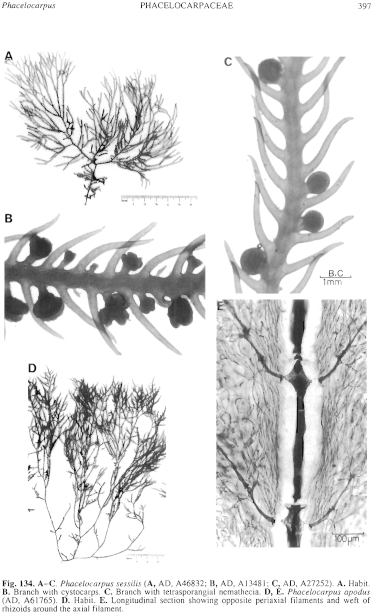|
|
|
|
|
|||||||||||
|
Electronic Flora of South Australia Species Fact Sheet
Phylum Rhodophyta – Class Florideophyceae – Order Gigartinales – Family Phacelocarpaceae
Selected citations: De Toni 1900: 392. Kylin 1932: 52. Searles 1968: 10, figs 2–4, pl. 1.
Thallus (Fig. 134D) medium to dark red-brown, (5–) 10–30 cm high, with a terete stipe 5–20 mm long and 1–3 (–4) mm in diameter, much branched irregularly but largely complanately for 4–5 orders, branches 1–2 (–2.5) mm broad, rachides terete below, mostly compressed and (400–) 500–800 µm broad, usually with a distinct midrib and marginal flanges. All branches bearing distichous, compressed, evenly tapering, pointed, ramuli, (150–) 250–400 µm in basal width, 1–2 mm long, separated on the rachis by rounded sinuses 100–150 (–300) µm wide; upper ramuli often but not always reflexed alternately above and below the plane of branching. Holdfast discoid, 2–5 mm across; epilithic or rarely epiphytic. Structure uniaxial, developing a prominent axial filament (Fig. 134E) with four periaxial cells, the lateral two developing into filaments with alternate ones forming the ramuli; rhizoids moderately well developed around the axial filament. Cortex pseudoparenchymatous, inner cells ovoid and 30–50 µm in diameter, outer cells 1.5–2.5 µm in diameter and L/D 0.8–1.5; refractive inclusions in cortical cells absent or present but sometimes inconspicuous; rhodoplasts discoid to elongate.
Reproduction: All reproductive bodies on the rachis margin, developed from the periaxial filament between two teeth. Sexual thalli dioecious. Procarps with one or two 2-celled carpogonial branches and an auxiliary cell, formed in clusters on short axillary branchlets. Cystocarps (Fig. 135A) stalked, ovoid, bilabiate, 500–900 µm broad, with a thick pericarp along the ostiolar slit, enclosing the carposporophyte (Fig. 135D) with a basal reticulate fusion cell and erect gonimoblast filaments with paired, ovoid to clavate, terminal carposporangia 3–6 µm in diameter. Spermatangial nemathecia (Fig. 135B) ovoid, 450–700 µm in diameter, sessile on rachis between the teeth, with spermatangia in channels separated by sterile tissue (Fig. 135E).
Tetrasporangial nemathecia (Fig. 135C) usually sessile, sometimes short-stalked and occasionally surmounted with sterile branchlets, subspherical to ovoid, 350–600 µm in diameter, with tetrasporangia in channels between sterile tissue, elongate, 25–45 µm long and 6–9 µm in diameter, zonately divided (Fig. 135F).
Type from southern Aust.; in Herb. Agardh, LD, (28531 is labelled 'type' but is cystocarpic, whereas J. Agardh referred to sessile nemathecia only).
Selected specimens: Whitford Beach, Perth, W. Aust., 6 m deep (Cook, 20.viii.1979; AD, A50568). Elliston, S. Aust., 7 m deep (Shepherd, 21.x.1970; AD, A37589). Wanna, S. Aust., drift (Womersley, 19.ii.1959; AD, A22374). Althorpe I., S. Aust., 9–12 m deep N side (Baldock, 4.i.1964; AD, A27216). West I., S. Aust., 5–7 m deep (Cheshire, 25.x.1992; AD, A61765). Port Elliot, S. Aust., drift (Womersley, 17.x.1948; AD, A9453). Pennington Bay, Kangaroo I., S. Aust., drift (Womersley, 25.i.1946; AD, A3007). Robe, S. Aust., 13 m deep on W coast (Mitchell, 25.v.1963; AD, A26489). Garden Beach, Portland, Vic., drift (Beauglehole, 18.viii.1951; AD, A21676). Walkerville, Vic., drift (Sinkora A2362, 10.iii.1977; AD, A48368). Dover I., Bass Strait, Tas., 10 m deep (Collings, 18.xii.1990; AD, A60859). Low Head, Tas., drift (Cribb 72.28, 14.ix.1950; AD, A16266). Crayfish Point, Taroona, Tas., 0–6 m deep (Sanderson, 29.v.1992; AD, A61760). Broulee, N.S.W., in rock pools (Rick, Aug. 1963; AD, A27464).
Distribution: Whitford Beach, W. Aust., to Broulee, N.S.W., and around Tasmania.
Taxonomic notes: Phacelocarpus apodus is usually a moderately deep water species, most closely related to P. peperocarpos but slenderer and with tetrasporangial and spermatangial nemathecia sessile or nearly so on the rachis, in contrast to distinctly stalked ones in the latter. Some plants may be intergrades between it and P. peperocarpos, and others between P. apodus and P. sessilis.
References:
AGARDH, J.G. (1872). Bidrag till Florideernes Systematik. Acta Univ. hind. 8, 1–60.
AGARDH, J.G. (1876). Species Genera et Ordines Algarum. Vol. 3, Part 1 - Epicrisis systematis Floridearum, pp. i-vii, 1–724. (Weigel: Leipzig.)
AGARDH, J.G. (1879). Florideernes morphologi. K. Svenska Vetensk. Akad. Handl. 15(6), 1–199, Plates 1–33.
DE TONI, G.B. (1900). Sylloge Algarum omnium hucusque Cognitarum. Vol. 4. Florideae. Sect. 2, pp. 387–776. (Padua.)
KYLIN, H. (1932). Die Florideenordnung Gigartinales. Lunds Univ. Årsskr. N.F. Avd. 2, 28 (8), 1–88, Plates 1–28.
SEARLES, R.B. (1968). Morphological studies of red algae of the order Gigartinales. Univ. Calif Pubis Bot. 43, vi + 1–86, Plates 1–12.
The Marine Benthic Flora of Southern Australia Part IIIA complete list of references.
Publication:
Womersley, H.B.S. (14 January, 1994)
The Marine Benthic Flora of Southern Australia
Rhodophyta. Part IIIA, Bangiophyceae and Florideophyceae (to Gigartinales)
Reproduced with permission from The Marine Benthic Flora of Southern Australia Part IIIA 1994, by H.B.S. Womersley. Australian Biological Resources Study, Canberra. Copyright Commonwealth of Australia.
Illustrations in Womersley Part IIIA, 1994: FIGS 134D, E, 135.

Figure 134 enlarge
Fig. 134. A–C. Phacelocarpus sessilis (A, AD, A46832; B, AD, A13481; C, AD, A27252). A. Habit. B. Branch with cystocarps. C. Branch with tetrasporangial nemathecia. D, E. Phacelocarpus apodus (AD, A61765). D. Habit. E. Longitudinal section showing opposite periaxial filaments and weft of rhizoids around the axial filament.

Figure 135 enlarge
Fig. 135. Phacelocarpus apodus (AD, A61765). A. Branch with cystocarps. B. Branch with sessile spermatangial nemathecia and young branchlets. C. Branches with tetrasporangial nemathecia. D. Section of cystocarp across the ostiolar slit. E. Longitudinal section of spermatangial nemathecium. F. Longitudinal section of tetrasporangial nemathecium.

|
Email Contact: State Herbarium of South Australia |

|